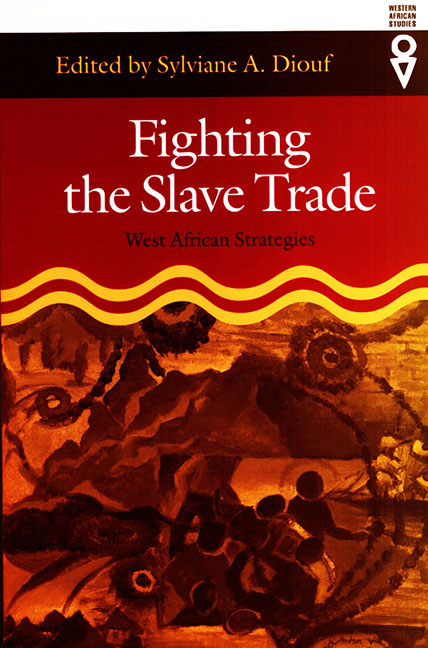Book contents
- Frontmatter
- Contents
- Preface
- Introduction
- PART 1 DEFENSIVE STRATEGIES
- PART 2 PROTECTIVE STRATEGIES
- PART 3 OFFENSIVE STRATEGIES
- 8 Igboland, Slavery, and the Drums of War and Heroism
- 9 “A Devotion to the Idea of Liberty at Any Price”: Rebellion and Antislavery in the Upper Guinea Coast in the Eighteenth and Nineteenth Centuries
- 10 Strategies of the Decentralized: Defending Communities from Slave Raiders in Coastal Guinea-Bissau, 1450–1815
- 11 The Struggle against the Transatlantic Slave Trade: The Role of the State
- 12 Shipboard Revolts, African Authority, and the Transatlantic Slave Trade
- Epilogue: Memory as Resistance: Identity and the Contested History of Slavery in Southeastern Nigeria, an Oral History Project
- Contributors
- Index
10 - Strategies of the Decentralized: Defending Communities from Slave Raiders in Coastal Guinea-Bissau, 1450–1815
from PART 3 - OFFENSIVE STRATEGIES
Published online by Cambridge University Press: 30 August 2017
- Frontmatter
- Contents
- Preface
- Introduction
- PART 1 DEFENSIVE STRATEGIES
- PART 2 PROTECTIVE STRATEGIES
- PART 3 OFFENSIVE STRATEGIES
- 8 Igboland, Slavery, and the Drums of War and Heroism
- 9 “A Devotion to the Idea of Liberty at Any Price”: Rebellion and Antislavery in the Upper Guinea Coast in the Eighteenth and Nineteenth Centuries
- 10 Strategies of the Decentralized: Defending Communities from Slave Raiders in Coastal Guinea-Bissau, 1450–1815
- 11 The Struggle against the Transatlantic Slave Trade: The Role of the State
- 12 Shipboard Revolts, African Authority, and the Transatlantic Slave Trade
- Epilogue: Memory as Resistance: Identity and the Contested History of Slavery in Southeastern Nigeria, an Oral History Project
- Contributors
- Index
Summary
The Balantas are fairly savage blacks. They have trade
with Beafares and Buramos, and meet them at their fairs.
The adults can only bring themselves to see our people
reluctantly, and they refuse to be slaves of ours: [if enslaved]
they die from their obstinancy.
—André Alvares Almada, Tratado breve dos rios de Guiné, 1594HISTORIANS HAVE BEEN MUCH MORE concerned with explaining questions surrounding how Africans produced, transported, and sold captives than with exploring African strategies against the slave trade. In some instances, strong groups generated captives through kidnapping, raiding, and sentencing criminals (see esp. Larson 2000, 12–16; Hawthorne 1999; Walvin 1992, 26; Rawley 1981, 272). In others, states harvested them through large-scale warfare conducted beyond their borders on “slaving frontiers.” Onto these frontiers, elites sent armies that entered like powerful waves, dragging some victims away to the sea and turning those who remained into “human flotsam” (Miller 1988, 149).
Those affected by these invasions were often members of less militarily powerful, politically decentralized societies. Indeed, historians have generally agreed that “[o]n the whole it is probably true to say that the operation of the slave trade may have tended to integrate, strengthen and develop unitary territorial authority, but to weaken or destroy more segmentary societies” (Fage 1969, 402; see also Boahen 1989, 61; Manning 1990, 132; Klein 1992, 40–41). This is largely because states had a greater ability to organize people for large-scale projects such as defending communities against attack, conducting raids, and moving captives over long distances (esp. Lovejoy and Hogendorn 1979).
But what happened to the people Joseph Miller dubbed flotsam—individuals who comprised the decentralized societies that remained outside the control of states but on their slaving frontiers? Were they simply passive victims? Did they do little more than struggle to keep their heads above water as they were tossed in the turbulence of “wildly swirling currents of political and economic change” (Miller 1988, 149)? Were they unable to respond to the challenges of a new era? Or did they fight back, adopt strategies to defend their communities against the slave trade?
With a focus on the Guinea-Bissau region of the Upper Guinea Coast, an area that sat on the slaving frontiers of the powerful interior state of Kaabu and the smaller coastal state of Casamance, this chapter will begin to answer these questions.
- Type
- Chapter
- Information
- Fighting the Slave TradeWest African Strategies, pp. 152 - 169Publisher: Boydell & BrewerPrint publication year: 2004

